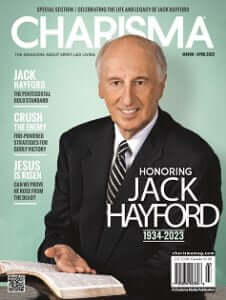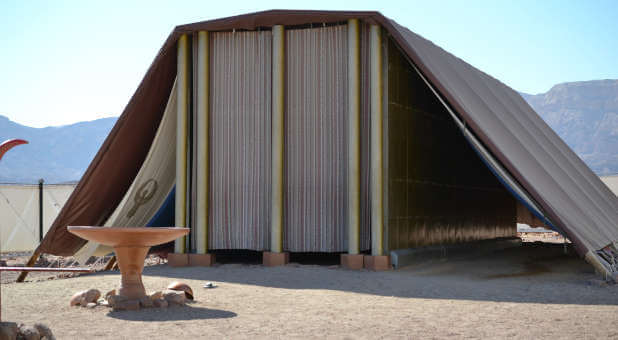Ever since I was a small child in Hebrew school classes, I was fascinated by the Tabernacle. I was amazed that when the Creator of the universe, the One who was all-knowing, all-powerful and all places wanted His people to build a home for Him, He asked them to build Him a tent.
Not a palace of stone, but a tent.
Years later when I became a believer in Yeshua (Jesus), I found Exodus 25:8, 40 and Hebrews 8:5; these verses caused me to begin studying the Tabernacle in more detail.
“Have them make a sanctuary for Me, so that I may dwell among them. 9You are to make it all precisely according to everything that I show you—the pattern of the Tabernacle and the pattern of all the furnishings within—just so you must make it” (Ex. 25:8-9).
“See that you make them according to their pattern being shown to you on the mountain” (Ex. 25:40).
“They offer service in a replica and foreshadower of the heavenlies—one that is just as Moses was instructed by God when he was about to complete the tabernacle. For He says, “See that you make everything according to the design that was shown to you on the mountain” (Heb. 8:5).
The word pattern in the text seemed to pop off of the page as if in 3D and this drove me to look at and search for every element that was commanded to be used in its construction. As I did, I found that everything that was used to build the Tabernacle and its furnishings had a symbolic prophetic nature.
From the wood used to build the poles that held up the curtain, to the Ark of the Covenant, each individual piece was designed by G-D and perfectly integrated to share something about His redemptive plan for mankind, and each piece in some way focused our attention on Yeshua.
I spent hours and hours digging into each and every piece and was amazed time after time how intricately G-D designed each cell of the Tabernacle so that every piece connected to every other piece to weave a beautiful tapestry depicting His plan to redeem mankind.
Recently, however, as I was reading through Exodus again, two different words popped off of the page and caused me to read these words from a different perspective. These two words are “sanctuary” and “dwell.” These words changed my focus on the Tabernacle and I hope they will change yours a little also.
While it is absolutely true and extremely important to remember that when G-D provided to Moses the blueprints for the Tabernacle, the materials which were used and the furniture was designed purposely to tell G-D’s prophetic plan.
However, the Bible actually states that the purpose of the Tabernacle was to provide a sanctuary and a dwelling place for G-D. Now, before I go on, please note that I know that G-D didn’t need a tent to have a home. After all, Isaiah 66:1 tells us: “…that heaven is My throne, and the earth is My footstool.”
So, because the purpose of the tabernacle was so that it would be a sanctuary and dwelling place for G-D, I began to look into these two concepts. First, a sanctuary by definition is a sacred place or holy place, and a dwelling is a place to abide in or live in.
Being that we know that G-D didn’t need a sacred place or a dwelling for Himself, we must conclude the purpose of the Tabernacle was so that we would have such a place, a sacred or holy place to dwell in with G-D. However, the more I studied, the more I realized that the Tabernacle wasn’t just a replica of what is in heaven, but was also a visual example for us. If the Tabernacle was G-D’s design for His home on earth, wouldn’t it stand to reason that the Tabernacle was also His design for what our homes should be?
Now, before you start thinking that I am encouraging everyone reading this to sell their houses and move to tents, that is not where I am going. I believe there is a deeper and much more meaningful pattern in the Tabernacle that G-D wants us to design our homes according to.
In this blog, I will only be looking at one aspect of the pattern and its meaning for us. If our homes are to follow the pattern that G-D provided for a home, then our homes must be more than just places in which we eat and sleep. Our homes must also be sanctuaries, holy places, sacred spaces.
I believe the design of the Tabernacle provides a pattern for our homes and there was a reason the Tabernacle had three distinct and separate sections.
The Outer Court: (Our patios, our backyards); this space was open and available not only to the priests and Levites, but also to anyone who chose to come to the Tabernacle. Our homes should likewise have space where everyone is welcome, where both those who know G-D and those who do not yet know Him may come and fellowship.
The Holy Place: (Our living rooms, or Dens); this space was just available to the Levites and Priests. Our homes should have spaces where only those who are in relationship with G-D are welcomed. This space must be sacred and holy, a safe space for our families and friends to fellowship with each other and G-D. (As you read this, please understand that I am not saying we should never invite those who do not yet believe in Yeshua into our homes. I am simply providing a spiritual application for the Tabernacle pattern.)
The Holy of Holies: (Our Bedrooms or Prayer Rooms) This space was only for the High Priest. This space in our home must be limited only to those and that which is holy and sacred. There is a reason for what we read in Matthew 9:23-25: Yeshua was honoring and following this Tabernacle pattern.
“When Yeshua came into the synagogue leader’s house and saw the flute players and the noisy crowd wailing, He said, ‘Go away, for the girl isn’t dead, but sleeping.’ And they began jeering at Him. But when the crowd had been cleared out, He went in and took her hand, and the girl got up” (Matt. 9:23-25).

In the Holy of Holies we as individuals boldly enter into G-D’s presence to intercede concerning the news of the day both good and bad. This is only one example of the many patterns provided to make our homes a Tabernacle, or Sacred Place of Dwelling. In future blogs, or maybe a new book, I will share more.
Bring Charisma magazine home with a subscription today!
Eric Tokajer is the author of “Overcoming Fearlessness,” “What If Everything You Were Taught About the Ten Commandments Was Wrong?,” “With Me in Paradise,” “Transient Singularity,” “OY! How Did I Get Here?: Thirty-One Things I Wish Someone Had Told Me Before Entering Ministry,” “#ManWisdom: With Eric Tokajer,” “Jesus Is to Christianity as Pasta Is to Italians” and “Galatians in Context.”






Leave a Comment
You must be logged in to post a comment.